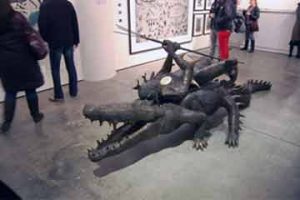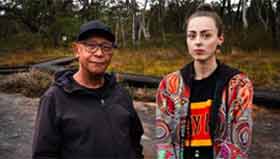Emigrate-to-Australia is sharing a series of articles on the delights of Australia’s Heritage. Here is our 4th Update!
In our next article on the cultural treasures to greet you when you visit or migrate to Australia, we look at some indigenous art. Australia’s local art is a rich cultural tapestry woven by its First Nations people, and nowhere is this more evident than in the diverse array of Indigenous sculptures and carvings that tell the stories of the land’s ancient history. From the captivating ‘Fruit Bats’ sculpture by Lin Onus to the hauntingly beautiful Pukamani funeral poles of the Tiwi people, these artistic expressions offer a glimpse into the spiritual and cultural significance of Australia’s Aboriginal communities.
The ‘Fruit Bats’ sculpture, with its unique incorporation of the iconic Hills Hoist clothesline, is a testament to the creativity and resourcefulness of Indigenous artists. Traditional cross-hatching designs adorn the life-sized fruit bats, hanging in a mesmerizing display that draws visitors into the heart of Aboriginal culture. Similarly, the mass of hollow log coffins from central Arnhem Land housed in the National Gallery invites exploration and contemplation, showcasing the diversity and depth of Indigenous artistic expression.
Camp dog sculptures, unassuming yet powerful in their representation, capture the essence of real camp dogs that populate Indigenous communities. Bush Critter sculptures, carved with wild expressions, reflect the surprises of the bush, creating a connection between art and nature. Dennis Nona’s exquisite bronze and aluminum sculptures, particularly those of stingrays, add a touch of finesse and exoticism to the cultural landscape.

Dennis Nona’s alligator sculpture
While these artworks reflect both everyday needs and ceremonial purposes, recent incidents of vandalism highlight the urgent need for greater education and respect. Ancient Aboriginal rock carvings, some dating back thousands of years, have been marred by scratches, fire remnants, and motorcycle tracks. The damage not only impacts the physical sites but also inflicts emotional wounds on the Indigenous communities connected to these sacred places.
Local Aboriginal woman Minmi Gugubarra expresses the deep emotional toll of the vandalism, emphasizing that these carvings are more than drawings—they are lifeblood, carrying the stories and spirituality of her people. The call for better education resonates strongly, as many Australians may not fully understand the historical significance of these sites, some of which predate structures like the pyramids of Egypt. If you are migrating to Australia ensure you learn about the amazing indigenous artifacts so that you can help to spread the word and protect them!

Gavi Duncan (left) and Minmi Gugubarra (right)
Share the emotional toll of vandalism on art.
Gavi Duncan, a Gomilaroi, Mandandanji, and Awaba man, emphasizes the importance of recognizing and respecting these sites, which are older than iconic landmarks worldwide. The need for better protection, education, and consultation with Aboriginal communities is clear. Vandalism reflects a broader issue of under-education about the significance of these places, prompting a call for more comprehensive efforts to bridge the cultural gap.
While incidents of vandalism cast a shadow, there are ongoing efforts by organizations like the National Parks and Wildlife Service (NPWS) and the Forestry Corporation to work with local Aboriginal communities. Signs at sites like Bulgandry Aboriginal Art Site and collaborations with cultural heritage supervisors demonstrate a commitment to educating visitors about the sacred nature of these locations.
Australia’s Indigenous art stands as a testament to the enduring spirit of its First Nations people. As we marvel at these expressions of culture, it is crucial to recognize the responsibility we all share in preserving and respecting the sacred sites that hold the stories of Australia’s ancient past. Through education, consultation, and increased awareness, we can ensure that these cultural treasures continue to inspire and connect us all.
There are many resources online if you would like to learn more or visit your local museum when you arrive in Australia.
For more information as to how we assist with migration to Australia, please contact
Greg Veal at [email protected]
The phone number for Emigrate to Australia is +44 207 427 5290

